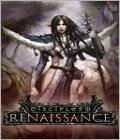Disciples III: Renaissance is the next title in the award winning Disciples series and represents a leap forward in the evolution of the turn-based RPG/strategy genre. Building on the successes of the first two games, DIII introduces a host of new features as well as the compelling gameplay that made the previous titles such hits.
As a Lord of one of the fantastical races of Nevendaar you must fight to restore your deity's rule over your world. There are three playable races to choose from; the Empire, the Elven Alliance and the notorious Legion of the Damned.
For the first time in the series the gloriously ominous and notoriously gloomy world of Disciples is rendered in full 3D, allowing the player to experience this realm as it should be. Disciples uses its own Virtual Dream engine to render the stunning 3D environments.
Empire Hero Armor
Upgrading the armor of the Empire hero will affect both the look of the hero in all of the game screen modes, as well as greatly influence the hero's ability to launch offensives and defend himself.
When receiving the officers ranks, the beginner imperial commander gets their first set of armor. Usually, the armor is built rugged and reliable to protect its owner in battle. it was not designed for style or to look nice.
When heading to his first assignment, an officer puts on his chest armor. A simple, blatantly forged shell without any of the ornaments used by the warriors of the Empire. The head of the knight is protected by a steel helmet detailed in the best tradition of the imperial masters. Such a helmet is given to each one who becomes an infantry soldier. The warrior’s hands are protected with sabre steel covers, which impose almost no restrictions on hand movement and weigh very little. However, they can only protect from light strikes.
The shoulders are covered with lightweight shoulder straps allowing for free and easy mobility. Unfortunately, the same as with the hand covering, the strength of the armor is reduced for the sake of convenience and mobility.
Legs are placed in the soldier’s pants from leather tanning, so as not to lose speed in battle. But the legs are not very well protected against strikes made by infantry boots, which are made of leather with steel inserts that are used to make blows.
If the young knight wants to be better and wear beautiful things, he will have to take care of it himself. He will have to steal the armor in battle, claiming it as a reward for successfully performing the operation. Or, simply claim what he finds when roaming or patrolling the lands of Nevendaara.
The exception is personal weapons. Typically, the first sword a warrior receives will be produced on his own. Or, he will receive one as an inheritance. The family sword, symbolic of the honor and dignity of any knights Empire will pass from generation to generation, having been cared for, prayed with, and sworn upon.
It just so happens that the first sword does not always have the best characteristics because the master armors are constantly improving their skills. Sometimes a knight can acquire a better blade. In that case, the first sword is passed to the youngest family member. A son, brother, or nephew. Or, it’s stored as a shrine in the family castle.
Key features:
- Three playable races - The Empire, the Legions of the Damned and the Elven Alliance. Each race has its own unique units and city design.
- Cities, locations, units and other game assets are now represented in full 3D.
- Advances in the gameplay allow increased fluidity in multiplayer games and less downtime when playing alone.
- A new upgrade system allows the player to assign attributes to your leaders. This RPG system employs inventories and new stats and abilities.
- Visual representation of character's equipped armor, weapons and artifacts.
Release date: Q1 2009
More articles about Disciples III: Renaissance











 Disciples III: Renaissance is a standalone turn-based RPG/strategy game set in an expansive fantasy world, offering players action, adventure and glory. Stunning 3D environments, three playable races, and multiplayer functionality all combine to offer an outstanding gameplay experience.
Disciples III: Renaissance is a standalone turn-based RPG/strategy game set in an expansive fantasy world, offering players action, adventure and glory. Stunning 3D environments, three playable races, and multiplayer functionality all combine to offer an outstanding gameplay experience.



